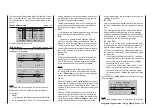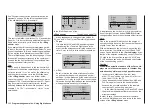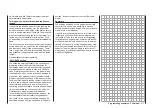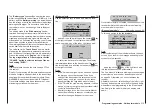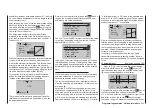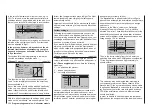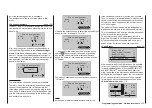
317
Programming examples - F3A model
half throttle and idle. Therefore program the mixer
asymmetrically, if applicable.
Turning away with the ailerons/landing flaps ex-
tended
If you move the ailerons upward for the landing, the
result is often a turning away over the longitudinal
axis due to various servo paths of the aileron servos
or due to design precisions. Therefore, the model be-
gins to automatically hang the left or right wing. This
is also easy to compensate for with a mixer “C1
AI” depending on the position of the ailerons/landing
flaps.
The mixer must be switched on and off with the same
switch with which you can switch the aileron/landing
flap function on and off (see previous page). There-
fore, it only works with the aileron/landing flap func-
tion activated. The appropriate value must be tested
in flight.
One additional comment regarding …
“FAIL-SAFE setting”
You utilize the safety potential of this option by pro-
gramming at least the motor throttle position for
combustion models to idle and the motor function for
electrically powered models to stop for a Fail-Safe
case. If interference should occur, the model is then
less likely to fly off on its own and cause damage to
property or even personal injury. If you additionally
program the fail-safe positions of the rudders to that
the model flies in gently sinking circles in the event of
a failure, there is a good chance that the model even
lands relatively gently on its own in the event of a
continuing connection failure. You also have sufficient
time to re-establish the connection if the entire 2.4
GHz frequency band is temporarily disrupted.
In the receiver’s condition as supplied, however, the
servos maintain their last validly recognized posi-
tion (“hold”) in the event of a fail-safe situation. As
described on page 220, you can define a “Fail-safe
position” for each receiver servo output (Fail-safe
mode).
Summary
The settings described on this page are especially
useful for the “expert” who would like to have an
entirely neutral, precisely flying F3A model acrobatic
model at his or her disposal.
It should be mentioned this takes a lot of time, effort,
instinct and know-how. Experts even program dur-
ing the flight. To do this, however, is not suggested
for an advanced beginner who ventures into an F3A
acrobatic model. It would be best to turn to an expe-
rienced pilot and carry out the settings step by step
until the model has the desired neutrality in its flight
behavior. Then the pilot can begin to learn the not
always easy to perform acrobatic figures with a model
which flies faultlessly.
Summary of Contents for HoTT MC-16 Series
Page 1: ...Programming Manual mc 16 mc 20 HoTT 1 en mc 16 mc 20...
Page 27: ...27 For your notes...
Page 53: ...53 For your notes...
Page 61: ...61 For your notes...
Page 65: ...65 For your notes...
Page 71: ...71 For your notes...
Page 103: ...103 For your notes...
Page 107: ...107 For your notes...
Page 111: ...111 For your notes...
Page 155: ...155 For your notes...
Page 165: ...165 For your notes...
Page 201: ...201 For your notes...
Page 229: ...229 For your notes...
Page 231: ...231 For your notes...
Page 261: ...261 For your notes...
Page 265: ...265 For your notes...
Page 301: ...301 For your notes...
Page 327: ...327 For your notes...
Page 328: ...328 For your notes...

